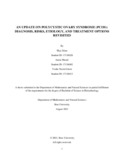| dc.contributor.advisor | Haque, Fahim Kabir Monjurul | |
| dc.contributor.author | Islam, Hiya | |
| dc.contributor.author | Masud, Jaasia | |
| dc.contributor.author | Islam, Yushe Nazrul | |
| dc.date.accessioned | 2021-10-27T06:21:11Z | |
| dc.date.available | 2021-10-27T06:21:11Z | |
| dc.date.copyright | 2021 | |
| dc.date.issued | 2021-08 | |
| dc.identifier.other | ID 17136020 | |
| dc.identifier.other | ID 17136002 | |
| dc.identifier.other | ID 17136013 | |
| dc.identifier.uri | http://hdl.handle.net/10361/15567 | |
| dc.description | This thesis is submitted in partial fulfillment of the requirements for the degree of Bachelor of Science in Biotechnology 2021. | en_US |
| dc.description | Catalogued from PDF version of thesis. | |
| dc.description | Includes bibliographical references (pages 52-64). | |
| dc.description.abstract | Polycystic Ovary Syndrome or PCOS is the most common endocrine disorder in women of reproductive age, which is still incurable. Despite its prevalence, little is known about its etiology. In this review article, the up-to-date diagnostic features and parameters recommended on the grounds of evidence-based data and veteran consensus are explored. The ambiguity and insufficiency of data when diagnosing adolescent women have been put under special focus. We look at some of the most recent research done to establish relationships between different gene polymorphisms with PCOS in various populations along with the underestimated impact of environmental factors like endocrine-disrupting chemicals (EDC) on the reproductive health of these women. Furthermore, the article concludes with existing treatment options and the scopes for advancement in the near future. Through multiple randomized controlled studies and clinical trials conducted over the years, various therapies based on their efficacy have been considered as a form of potential treatment and are described in this article. Common therapies ranging from metformin to newly found alternatives based on vitamin D and gut microbiota could shine some light and guidance towards a permanent cure of this metabolic syndrome in the future. | en_US |
| dc.description.statementofresponsibility | Hiya Islam | |
| dc.description.statementofresponsibility | Jaasia Masud | |
| dc.description.statementofresponsibility | Yushe Nazrul Islam | |
| dc.format.extent | 64 pages | |
| dc.language.iso | en | en_US |
| dc.publisher | Brac University | en_US |
| dc.rights | Brac University theses are protected by copyright. They may be viewed from this source for any purpose, but reproduction or distribution in any format is prohibited without written permission. | |
| dc.subject | PCOS | en_US |
| dc.subject | Genetic association | en_US |
| dc.subject | Endocrine disorder | en_US |
| dc.subject.lcsh | Polycystic ovary syndrome. | |
| dc.title | An update on Polycystic Ovary Syndrome (PCOS): diagnosis, risks, etiology, and treatment options revisited | en_US |
| dc.type | Thesis | en_US |
| dc.contributor.department | Department of Mathematics and Natural Sciences, Brac University | |
| dc.description.degree | B. Biotechnology | |

